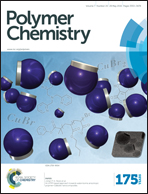Self-assembly and micelle-to-vesicle transition from star triblock ABC copolymers based on a cyclodextrin core†
Abstract
Three kinds of well-defined star triblock copolymers poly(methyl methacrylate)-b-poly(2-(diethylamino)ethyl methacrylate)-b-poly(poly(ethylene glycol)methyl ether methacrylate) based on a cyclodextrin core, CD-(PMMA63-b-PDEA15-b-PPEGMA9)21 (STBP1), CD-(PMMA63-b-PDEA15-b-PPEGMA14)21 (STBP2) and CD-(PMMA63-b-PDEA20-b-PPEGMA17)21 (STBP3), were designed and synthesized by the core-first ATRP method. The star triblock copolymers have low critical aggregation concentration values in aqueous solutions. Self-assemblies with different morphologies were obtained from the star triblock copolymers. STBP1 could directly self-assemble into micelles in pure water. Unexpectedly, the surrounding pH could induce micelle/vesicle morphology transition of the original STBP1 micelles. The transition was attributed to PDEA moieties responsive to the pH change instead of reassembly. But the pH variation had less influence on the morphologies of the vesicles self-assembled from STBP2. Using doxorubicin (DOX) as a model guest molecule, loading capacities of the star copolymer aggregates and the influence of the presence of the guest molecules on the morphologies of the aggregates were investigated. It was found that the drug loading capacities depended on the compositions of the star copolymers and the feed drug/copolymer ratio. The star polymer with high hydrophilic content showed high drug loading capacity. The DOX release from the loaded self-assemblies was pH tunable.


 Please wait while we load your content...
Please wait while we load your content...